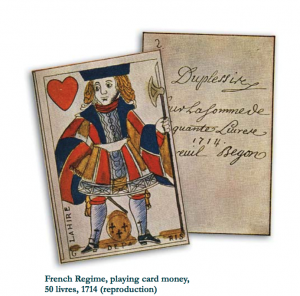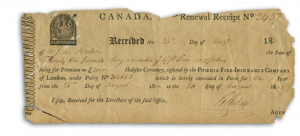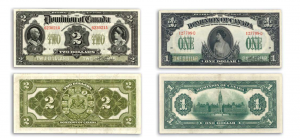By: Michael Flood
The Canadian Government just recently unveiled a new $10 bill – the chic new design has come along way from the earliest days of Canadian bank notes. Believe it or not, the first paper currency used in Canada was an inscribed playing card signed by the governor of what was then called New France.

Source: A History of the Canadian Dollar, Bank of Canada.
Yes, that’s right, the king of hearts used to serve as means of buying groceries. This method, however, is not the earliest form of monetary exchange that existed in what is now called Canada. The First Nations, who had an array of objects and precious goods that formed the basis for the first exchanges of value, preceded us. Wampum belts are the first example of such a good – in some cases, they were assigned extremely high because of their intricacy and, in the absence of money, and they functioned as a method of payment between colonists and Aboriginals.

Source: A History of the Canadian Dollar, Bank of Canada.
Fast forward a couple hundred years and the banking system had evolved. In fact, it became far more complex. The note in the image above is what was referred to as “Halifax Currency”, named after the city where it was used – at this time, those issuing receipts had to clearly state where the system of currency they were using which differed from region to region across North America. In “Halifax Currency”, 5 shillings was equal to 1 dollar.
Throughout the first half of the 18th century bills became more commonplace. They were printed in Quebec City during the War of 1812 so that soldiers could buy basic provisions.
In British Columbia, the first sign of bank notes came about in 1861. The Treasury of the Colony of British Columbia with the purpose of funding public infrastructure projects issued them. They quickly circulated, however, as there was a shortage of minted coins in the region.
The upstart of golf mining in B.C. also saw the use of gold dust as a form of currency throughout the second half of the 1800’s when it was discovered in the Fraser Valley.
It reached a point where there were so many forms of payment ranging from minted coins to gold to banknotes to raw materials, that the colonies of Canada has to seek reforms.
Eventually, this led to the establishment of the ‘Gold Standard’, which lasted from 1854 to 1914. This pegged the value of the Canadian dollar to the standardized value of Gold and created a more universal method for determining the value of money.
After abandoning the Gold Standard, Canada adopted the first standardized set of bills, which commonly featured the Governor General and his or her spouse.

Source: A History of the Canadian Dollar, Bank of Canada.
Bills were swapped almost every decade from that time until today, and it became commonplace to impose the image of a past Prime Minister.
With the latest bill, imprinted with a portrait of the heroic Viola Desmond, that trend is fading.
One can only speculate which Canadians will be the faces of the bills to come.

 Follow
Follow



